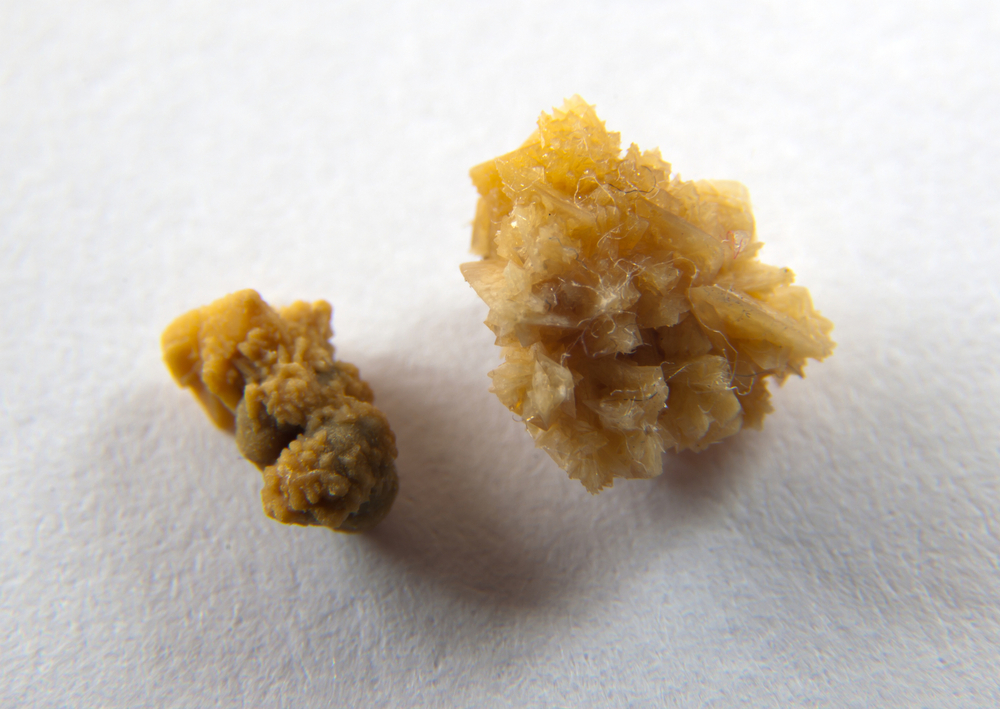Diet for calcium oxalate stones in dogs
Updated February 2024, by Kristina Johansen
In this guide to dietary management of calcium oxalate stones in dogs, our primary focus will be on diet. However, we will also delve into various relevant topics, such as:
- Signs and symptoms.
- Treatment options.
- The importance of Urinary pH and urine specific gravity (USG).
Let’s dive in!
Why did my dog form calcium oxalate stones, and what are they?
It’s not very well understood why some dogs develop calcium oxalate stones. Some suggest that higher levels of calcium, citrate, or oxalate in a dog’s urine may predispose the dog to develop this type of bladder stone. The fact is that we don’t know.
However, as with most health issues, some breeds – including Yorkshire terriers, miniature poodles and Shih Tzus – are more prone to developing them. It’s also interesting to note that bladder stones are more common in male dogs.
Calcium Oxalate stones form when two chemicals – calcium and oxalic acid – bind together in urine. Normally, calcium and oxalic acid mutually co-exist in your dog’s urine and don’t bind together. But under certain conditions, for example, if the urine pH is too acidic, the two bind to form a compound called calcium oxalate. The bladder cannot dissolve or excrete this compound, causing it to become lodged. High levels of these chemicals in the urine also increase the likelihood of them binding together to form calcium oxalate stones.
The signs and symptoms of calcium oxalate stones (CaOx)
The most common signs of stones in your dog’s bladder are difficulty urinating (dysuria) and blood in the urine (haematuria).
Urinating becomes difficult because the presence of stones in the bladder causes it to swell and become inflamed, or the stones physically obstruct the bladder, both of which mean urine isn’t able to pass through to the urethra (the tube that carries urine from the bladder and outside the body)
Haematuria happens because the stones rub against the bladder wall, causing damage, irritation and bleeding.
In case you’re curious, this is what a calcium oxalate stone would look like when removed. Imagine what this would feel like in your bladder.
How will my vet treat CaOx stones?
For most dogs, calcium oxalate stones are removed via surgery, which is the simplest, most direct way to remove them.
While there can be other options to remove stones (see below), surgery tends to be the only option when stones are bigger and when there are a lot of them. It is also the recommended method of removal for male dogs because there’s a higher risk the stones will cause obstruction and damage to the bladder.
Surgery doesn’t always remove every trace of the stones, which is why, following surgery, vets tend to ‘flush’ the bladder to remove any lingering traces of them. Unfortunately, even with flushing, removing everything can be impossible, meaning some trace of the stones remains. This is why it’s common for calcium oxalate stones to form repeatedly. However, dog owners can take measures to decrease the likelihood of this happening (see below).
If the calcium oxalate stones are small enough (and there aren’t many), flushing the bladder can remove them. This procedure is usually done when your dog is heavily sedated or under anaesthetic.
Stones can also be removed via a cystoscopy, a cystoscope passed up through the urethra and into the bladder to break down the stones. This produces stone fragments that are small enough to be expelled naturally through the urine. Again, this procedure will only work if the stones are small and there aren’t many of them.
This is not an exhaustive list of how calcium oxalate stones can be removed. Your veterinarian will discuss the options with you to find the one most suitable for your dog.
Diet for calcium oxalate stones in dogs
Nutrition plays a crucial role in managing and preventing the development of calcium oxalate stones in dogs.
To decrease the likelihood of your dog forming these stones, there are several key dietary modifications you should be making.
Water
Keep your dog well hydrated. Increased water consumption makes urine more dilute, which in turn dilutes the levels of chemicals that promote stone formation. You can help your dog drink more water by placing a few bowls of fresh water in different locations around the house. Ideally, we are aiming for a urine specific gravity (USG) below 1.020 (for reference, water is 1.000).
Oxalate
Avoid foods with high levels of oxalate, such as spinach, sweet potatoes, organ meat and brown rice. Instead, include foods low in oxalate such as apples (peeled), white rice, meats, and fish (except sardines) in your dog’s diet. It’s also a good idea to boil vegetables and discharge the water before giving them to your dog – this helps reduce their oxalate levels.
Calcium
Many people are afraid to add calcium to their dog’s diet because of the name “calcium oxalate stones”. However, adequate calcium intake is vital as it binds to oxalate in the digestive tract, limiting its absorption. In addition, calcium is an essential mineral, and a lack of calcium will be damaging and may lead to more severe health problems, including osteoporosis. Balance, not elimination, is the key. You can read more here: Calcium intake and urinary stone disease.
Sodium & Vitamin D
Excess sodium and vitamin D can increase urinary calcium excretion. Therefore, avoid providing your dog with extra sodium or vitamin D
Vitamin C
When vitamin C is metabolised and broken down, it produces oxalate – thus, avoiding vitamin C supplements avoids an increase in oxalate levels.
Vitamin B Compound
Vitamin B supplements are water soluble and are excreted in the urine. Therefore, in all cases of urinary tract stones, it is prudent to give a vitamin B complex supplement.
Fish oil
Calcium oxalate stones cause the bladder to become inflamed by rubbing up against the bladder wall. To help reduce this inflammation, you can give your dog fish body oil supplements. However, avoid cod liver oil, which contains vitamin D (see above).
It’s important to note that not all of the oxalate in your dog’s body stems from their diet. Some are produced naturally by your dog’s body, mainly the liver. Nonetheless, avoiding incorporating foods with high oxalate levels in your dog’s diet is an important preventative step against calcium oxalate stones.
Urine pH
Calcium oxalate stones form in urine that is too acidic (between pH 5.0-6.5). So another way calcium oxalate stones can be prevented is by maintaining a more basic urine pH – typically around pH 7.0. It’s worth noting that healthy dogs typically have a urine pH range of 6 to 7.5.
Generally, high-protein foods make your dog’s urine more acidic, while carbohydrates can make it more alkaline. However, it’s essential to note that many other factors can also influence urine pH.
If you want to monitor the pH of your dog’s urine, you can test it using a pH strip. Catch some of your dog’s first urine of the day midstream, preferably before a meal.
You may not be successful in keeping your dog’s urine pH exactly where you want it. The key is to monitor the pH and know where you are, but not to panic if the urine remains more acidic than you would like. And remember, it is more important to keep your dog’s urine dilute (<1.020) than to raise its pH.
Key takeaways
Bladder stones aren’t a pleasant thing for your dog to develop. They can be extremely painful as well as potentially fatal. But the good news is, as an owner, sticking to dietary recommendations and monitoring your dog’s urine can reduce the chances of them coming back in dogs who have previously had them.
Key nutritional goals include:
- Increase water consumption
- Feed a high-moisture diet
- Avoid high-oxalate foods and Vitamin C supplements
- Provide appropriate calcium intake and avoid excessive vitamin D.
- Consider fish body oil supplements
We have reached the end of the blog, and I hope you enjoyed reading it. Most importantly, I hope the information has helped you understand the necessary changes to manage your dog’s calcium oxalate bladder stones effectively. If you have questions, please email me at kristina@elmoskitchen.com
Meet Bobby
Before you go, I would like to introduce you to Bobby and share this lovely message I received from his owner.
“Thank you Kristina. 18 months on your diet for our calcium oxalate stone forming dog and we have no further stones and bladder is in good health. Prior to your diet his stones returned 9 months after surgery. Massive thank you for all your help and advice“

Just to let you know, the information provided in this blog is meant for informational and educational purposes only. Please don’t try to create or modify your dog’s diet based on the information provided. Diet formulation for dogs with health concerns is complex. If you’re considering a homemade diet for your dog, please ensure a qualified dog nutritionist formulates it.
Additional reading:
Diet & Health Advice
If you have a dog with calcium oxalate stones and would like to book a consultation, please email us, and we’ll be happy to help.
Book a Consultation

